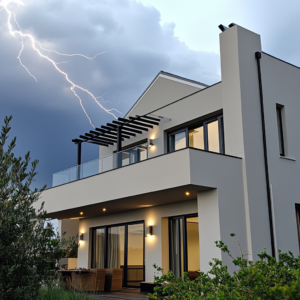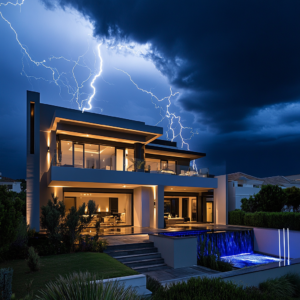What is the lifespan of lightning protection systems?
Introduction to Lightning Protection Systems
Lightning protection systems (LPS) are essential installations designed to safeguard buildings and other structures from the devastating effects of lightning strikes. These systems play a crucial role in preventing damage, reducing the risk of fire, and ensuring the safety of occupants within a building. By providing a direct path for the electrical discharge to follow safely into the ground, a lightning protection system helps avert the destructive forces that can result from a lightning strike.
At the heart of all effective lightning protection systems is a network of rods, cables, and ground electrodes. Lightning rods, typically made of conductive materials like copper or aluminum, are strategically placed on rooftops and other high points of a structure. These rods are connected to a series of conductors that route the high-voltage lightning current down safely into the earth. Ground electrodes, buried in the soil, act as a final point to disperse the electrical energy without harming the structure.
The primary objective of an LPS is to protect the structural integrity of a building while minimizing damage to electronic equipment and reducing the risk of fire. With the increasing frequency of extreme weather events, investing in a robust lightning protection system is more critical than ever. By understanding the importance and functionality of these systems, property owners can take proactive steps to shield their assets and ensure the safety of those within their premises. Prioritizing lightning protection not only promotes safety but also provides peace of mind when nature unleashes its formidable energy.

Components and Functionality of Lightning Protection Systems
Lightning protection systems are crucial for safeguarding buildings and infrastructure from the devastating effects of lightning strikes. Their primary purpose is to direct the electrical energy from a lightning strike safely into the ground, thus minimizing the potential for structural damage, fire, and electrical surges that could harm electronic equipment.
The main components of lightning protection systems include air terminals, conductors, ground electrodes, and bonding materials. Air terminals, often referred to as lightning rods, are strategically placed at the highest points of a building. These rods intercept the lightning strikes, providing a target for the lightning to strike in a controlled manner.
Once the lightning is captured by the air terminal, conductors come into play. These are typically made of highly conductive materials like copper or aluminum and are responsible for channeling the electrical energy from the air terminal down to the ground electrodes. It’s crucial that these conductors are unbroken, as any gaps can lead to dangerous arcing.
Ground electrodes are vital as they provide the path for the electrical discharge to safely dissipate into the earth. These are usually metal rods driven deep into the soil, ensuring a low-resistance path to ground.
Bonding materials ensure all metal components of a building are electrically connected to the lightning protection system. This prevents side flashes by ensuring all metal surfaces have the same electrical potential.
Together, these components form a robust network that safeguards structures from lightning damage, crucial for the safety and security of any property. Regular inspections and maintenance are essential to ensure all parts function correctly and remain effective over time.
The expected lifespan of lightning protection systems is a crucial consideration for both property owners and facility managers looking to safeguard their buildings. Typically, a well-designed and properly installed lightning protection system can last anywhere from 20 to 40 years. However, this range can vary depending on several factors such as the quality of materials used, regional climate conditions, and the frequency of lightning strikes in the area.
The foundational components of lightning protection systems—including air terminals, conductors, ground electrodes, and surge protectors—are generally designed to withstand harsh environmental conditions. Copper and aluminum, commonly used in these systems, are known for their durability and corrosion resistance, contributing to the system’s longevity.
The lifespan also depends on the initial installation quality. Employing certified professionals to install and periodically inspect the system ensures that it meets established safety standards and functions optimally over time. Regular inspections are recommended to identify and rectify any wear and tear caused by environmental factors or accidental damage.
It’s essential to recognize that as electrical codes and standards evolve, older systems might require upgrades to maintain compliance and efficacy. Hence, even as technology advances, investing in a robust lightning protection system today can offer decades of peace of mind and protection. Prioritizing quality materials and expert installation, along with ongoing maintenance, are key strategies in extending the lifespan of your lightning protection system.
Factors Influencing the Longevity of Lightning Protection Systems
The lifespan of lightning protection systems depends on various factors that can affect its durability and effectiveness over time. One of the key factors is the quality of materials used. Systems made with high-grade materials, such as copper or aluminum, are more likely to withstand severe weather conditions and offer long-lasting protection.
Installation quality is another crucial factor. A professionally installed system ensures that all components are properly connected and grounded, significantly reducing the risk of failure due to poor workmanship. Therefore, choosing an experienced technician is essential for optimizing the system’s lifespan.

Environmental conditions also play a significant role. Areas prone to frequent lightning strikes or harsh weather can put more stress on the system, possibly leading to quicker wear and tear. Additionally, corrosive environments, such as those near the coast, can deteriorate materials faster, affecting their ability to conduct lightning safely.
The frequency of maintenance checks is also critical. Regular inspections can identify and address wear and tear, such as loose connections or corrosion, before they become major issues. This not only extends the life of the system but also ensures ongoing effectiveness.
Lastly, technological advancements can influence longevity. Systems that incorporate the latest technology and design improvements are often more robust and efficient, providing better protection over the years. Being aware of these factors can help property owners choose the right system and strategies to maximize their investment in lightning protection.
Maintenance Tips to Extend the Life of Your Lightning Protection System
Maintaining your lightning protection system is crucial for ensuring its longevity and optimal performance. Regular maintenance not only prolongs the system’s lifespan but also strengthens its ability to safeguard your property from lightning strikes. Here are some practical tips to help you achieve that:
- Conduct Regular Inspections: Schedule routine inspections with a certified professional. These checks can identify potential issues such as corrosion, loose connections, or damaged components that need immediate attention.
- Clean Components: Ensure that all parts of the system, including conductors and air terminals, are clean and free of debris. Regular cleaning prevents corrosion and maintains efficient conductivity.
- Check Connections: Over time, connections can loosen due to weather fluctuations and structural changes. Periodically tighten all clamps and connectors to maintain a secure, reliable system.
- Monitor Structural Changes: Any modifications to your building, such as new roof installations or extensions, may affect the lightning protection system. Make sure the system adapts to these changes to maintain comprehensive protection.
- Protect Against Corrosion: Use corrosion-resistant materials and coatings, especially in coastal or industrial areas where metal deterioration is more likely.
- Replace Damaged Components: If any part of the system appears worn or defective, replace it promptly to prevent overall system failure during a storm.
- Document Maintenance Activities: Keep detailed records of all maintenance activities, inspections, and repairs. This documentation can assist in future assessments and improve the system’s management.
By following these maintenance tips, you can significantly increase the life of your lightning protection system and ensure continued security for your property. Regular upkeep not only saves you from costly repairs but also provides peace of mind during stormy weather.
Ensuring Long-Lasting Lightning Protection
To maximize the lifespan of your lightning protection system, proactive care and maintenance are key. A well-maintained system not only provides reliable protection but also ensures peace of mind during severe weather. Regular inspections should be a priority, ideally conducted by a professional, to identify and address potential issues before they compromise the system’s effectiveness.
Ensure all components, such as air terminals, conductors, and grounding rods, are in optimal condition. Corrosion is a major enemy, particularly for systems in coastal or industrial areas. Using corrosion-resistant materials and coatings can significantly extend the system’s life. Additionally, after any major storm or structural changes to the building, it’s wise to re-evaluate the system for integrity and performance.
Adapting to technological advancements can also play a role in longevity. Upgrading components to modern standards or integrating new technologies can enhance protection and efficiency. Moreover, clear communication between property owners and lightning protection professionals is essential. Comprehensive reporting from inspections and maintenance services should be maintained for reference.
By investing in regular maintenance and responding swiftly to necessary repairs, you ensure that your lightning protection system remains robust and efficient. Ultimately, a long-lasting lightning protection system not only safeguards your property but also fortifies its value, underscoring its importance as a critical investment in property protection. For enduring security against nature’s unpredictability, diligent attention to your system’s health is indispensable.
Find out if you need lightning protection: read our recent article here…
